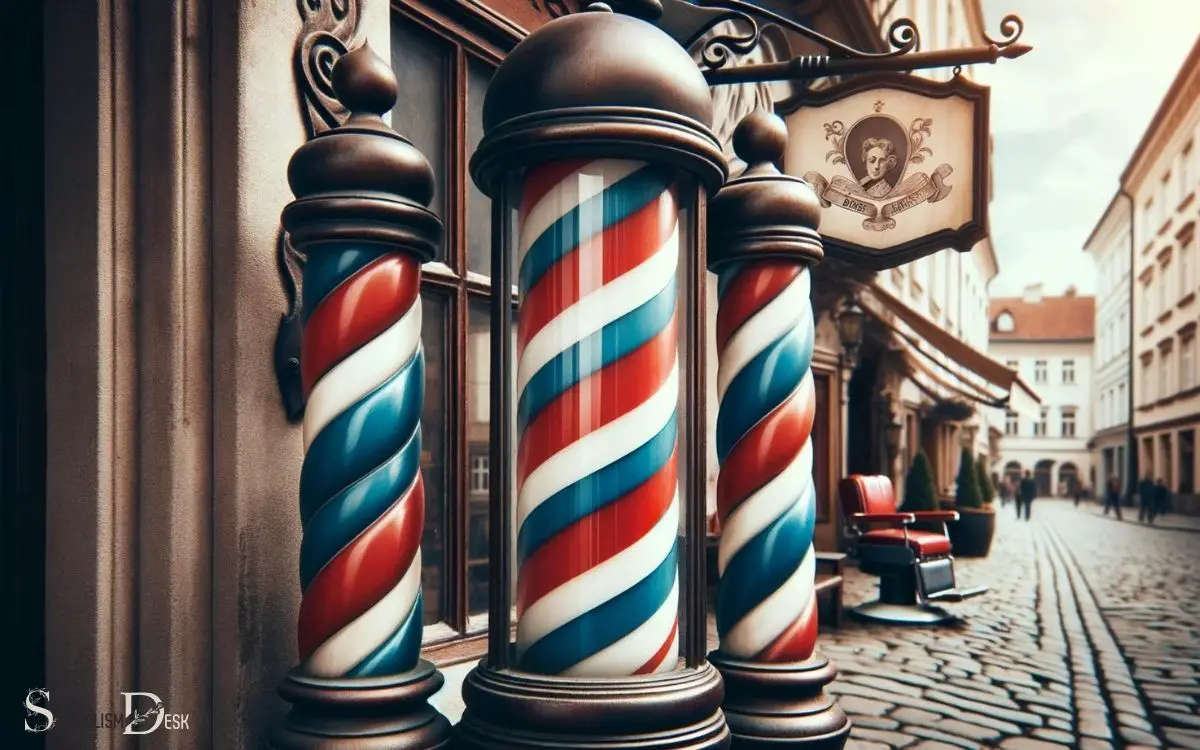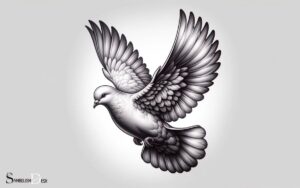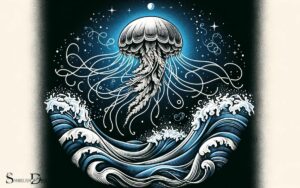What is the Symbolic Meaning of the Barber Pole? Explain!
The barber pole traditionally symbolizes the history of the barbershop’s role in healthcare, representing the blood and bandages associated with bloodletting, a medical procedure once performed by barbers.
The iconic barber pole, with its red, white, and sometimes blue stripes, dates back to the Middle Ages. It signifies a time when barbers performed various medical procedures, including bloodletting, which was believed to cure or prevent illness.
The red stripe represents the blood, the white signifies the bandages, and the blue (often found in American barber poles) is said to represent the veins or arterial blood, depending on the interpretation.
- Red Stripe: Blood from bloodletting
- White Stripe: Bandages used in the procedure
- Blue Stripe (U.S.): Veins or arterial blood
The barber pole—an emblem of a bygone era of medical barbering—continues to be an iconic symbol in the modern grooming industry.

Key Takeaway
3 Colors: Symbolic Meanings of the Barber Pole
| Color | Symbolic Meaning |
|---|---|
| Red | The color red in the barber pole symbolizes the blood because in medieval times barbers performed not only hair and beard grooming services but also tooth extractions and bloodletting. |
| White | The color white represents the bandages used to stem the bleeding after surgery, again referring to when barbers were also surgeons. |
| Blue | The color blue is believed to represent veins, acknowledging the barber’s historic role in bloodletting. However, the blue stripe is not included in all barber poles and is largely an American tradition. |
Historical Origins of the Barber Pole
The historical origins of the barber pole date back to the Middle Ages when barbers also served as surgeons and dentists, using the pole as a symbol of their medical services.
During this period, barbers would perform medical procedures such as bloodletting, which involved using leeches to draw blood from patients.
The white and red stripes on the barber pole represented the bandages and the blood-soaked towels used during these procedures. The addition of blue to the pole in some regions symbolized the vein that was being bled.
Over time, the barber pole became a recognized symbol for medical services and was later adapted to represent the profession of barbering.
Today, the iconic barber pole continues to be a symbol of both the historical significance and the modern practice of barbering.
Evolution of Barber Pole Symbolism
Having traced the historical origins of the barber pole, it is important to note that its symbolism has undergone significant evolution over the centuries.
The evolution of the barber pole’s symbolism reflects changes in societal perceptions and cultural practices. The table below illustrates the evolution of the barber pole’s symbolism, evoking an understanding of its transformation over time.
| Time Period | Symbolism |
|---|---|
| Medieval Times | Bloodletting and surgical procedures |
| 16th – 18th Century | Barbers also acted as dentists and surgeons |
| 19th Century | Symbolized bloody bandages and medicinal practices |
| Modern Era | Signifies a place for male grooming and relaxation |
This evolution showcases the shift from medical associations to its modern representation as a grooming establishment. Understanding the evolution of the barber pole’s symbolism provides insight into the changing societal roles and perceptions of barbershops.
Cultural Significance of the Barber Pole
The cultural significance of the barber pole is deeply rooted in history, reflecting the evolution of the barber profession and its symbolism. Understanding the historical significance of the pole and its evolution over time provides valuable insight into its cultural relevance.
Exploring the historical symbolism and evolution of the barber pole sheds light on its cultural significance within society.
Historical Symbolism of Pole
One can trace the historical symbolism of the barber pole back to its cultural significance in various societies.
The pole has held different meanings throughout history, reflecting the practices and beliefs of different cultures.
- In ancient Rome, barbers also performed minor surgeries, so the pole represented the bandages wrapped around a pole that patients would grip during the procedure.
- In medieval times, the pole was a symbol of the bloodletting process, with the red representing blood and the white representing bandages.
- In some cultures, the pole symbolized the staff that patients gripped during the bloodletting procedure, while in others, it represented the cloths that were used to wipe the blood.
These historical symbolisms highlight the diverse cultural significance of the barber pole and its evolution over time.
Evolution of Barber Pole
Significant cultural changes have shaped the evolution of the barber pole, reflecting the transformation of societal beliefs and practices.
Historically, barbers also performed surgeries and tooth extractions, thus the red and white stripes on the pole represented blood and bandages.
As medical practices evolved, the pole’s meaning shifted, and it became more closely associated with barber services.
In the United States, during the late 18th century, blue was added to represent the American flag.
Today, the barber pole stands as a symbol of both tradition and community. Its presence in modern barbershops serves as a nod to the past, preserving the heritage of the trade.
The evolution of the barber pole illustrates how symbols can adapt and endure, reflecting the cultural shifts and values of society.
Symbolism in Barbering Traditions
Barbering traditions hold deep historical significance. The barber pole represents more than just a place to get a haircut.
The symbolism is intertwined with cultural ties to the profession, reflecting a rich heritage that has evolved over time.
Understanding the evolution of barber symbolism sheds light on the enduring traditions and practices within the profession.
Historical Significance of Pole
Throughout history, barbers have prominently displayed their trade through the symbolic representation of the barber pole.
The pole has held significant historical significance, representing various aspects of the profession:
- Medical Origins: Originally, barbers were also medical practitioners, and the pole’s red and white spiraling colors represented bandages and bloodletting.
- Guild Affiliation: In the Middle Ages, barbers were part of medical guilds, and the pole served as a symbol of their profession.
- Modern Symbolism: Over time, the pole’s significance evolved, representing the dual role of barbers as both hairdressers and providers of medical services.
These historical elements have contributed to the enduring symbolism of the barber pole and its representation of the barbering profession.
This evolution of symbolism ties into the cultural significance and traditions associated with the profession.
Cultural Ties to Profession
Having evolved from its historical significance, the barber pole’s cultural ties to the profession are evident in the symbolism found within barbering traditions.
The red, white, and blue stripes on the pole are believed to represent blood, bandages, and veins, signifying the barber’s traditional role as a surgeon.
This symbolism dates back to a time when barbers not only cut hair but also performed surgical procedures. This symbolism dates back to a time when barbers not only cut hair but also performed surgical procedures. The red and white stripes of the barber pole are thought to represent blood and bandages, a nod to their dual profession. Over time, interpretations of such symbols have evolved, with some drawing far-fetched connections to esoteric ideas like the monster symbol and 666 meaning, though these theories are often rooted in modern conspiracy rather than historical fact. Such reinterpretations show how cultural symbols can be reimagined across different eras.
In addition, the pole’s colors also have cultural ties, with red representing arterial blood, blue representing venous blood, and white symbolizing bandages.
Furthermore, the pole’s spiraling design is said to symbolize the act of bloodletting, which was a common medical practice historically associated with barbers.
These cultural ties highlight the rich history and symbolism embedded within the profession of barbering.
Evolution of Barber Symbolism
The symbolic meaning of the barber pole has evolved over time, reflecting changes in the profession’s cultural significance and traditions.
In the early days, barbers not only cut hair but also performed medical procedures, leading to the incorporation of bloodletting and surgery in their services. As the profession evolved, so did the symbolism associated with the barber pole.
The evolution of barber symbolism can be seen in various traditions and cultural practices, including:
- Barber Surgeons: Historically, barbers were often also surgeons, and the barber pole represented their medical expertise.
- Community Hub: Barbershops became gathering places where people discussed news and local events, shaping the symbolic significance of the barber pole as a community center.
- Traditional Practices: The symbolism of the barber pole also reflects traditional grooming practices and the importance of personal grooming in different cultures.
This historical evolution has contributed to the modern interpretations of the barber pole, which continue to hold significance in the profession today.
Modern Interpretations of the Barber Pole
Exploring the evolving significance of the barber pole in contemporary society reveals its continued relevance and symbolism.
In modern times, the barber pole is often seen as a symbol of tradition, community, and the timeless art of grooming.
It represents a place of trust and a sense of belonging, as barbershops have historically been gathering places where people come together to socialize and exchange stories.
Additionally, the red, white, and blue colors of the barber pole continue to evoke a sense of patriotism in many communities, signifying unity and pride.
Moreover, the pole is a reminder of the skilled craftsmanship and professionalism of barbers, as well as a beacon of reliable service in an ever-changing world.
Global Variations of Barber Pole Symbolism
Embracing diverse cultural contexts, barbershop poles symbolize unique traditions and customs across the globe.
In different parts of the world, the symbolic meaning of the barber pole varies:
- United Kingdom: In the UK, the traditional red, white, and blue barber pole represents the bloodletting process that barbers used to perform in the medieval times. The red symbolizes blood, the white represents the bandages, and the blue signifies veins.
- Japan: In Japan, barbershops often display a distinct red and white striped pole. The colors are associated with good luck and protection from evil spirits, reflecting the cultural significance of these colors in Japanese traditions.
- Middle East: In some Middle Eastern countries, barbers use a blue and white striped pole, where the blue represents the Prophet Muhammad’s favorite color and is considered sacred in Islamic culture.
Conclusion
The symbolic meaning of the barber pole has evolved over time, reflecting the history and traditions of barbering.
From its origins as a medical symbol to its modern representation of the barbering profession, the barber pole holds cultural significance around the world.
Its colorful stripes and unique design continue to be a visual representation of the rich traditions and symbolism associated with the art of barbering.





